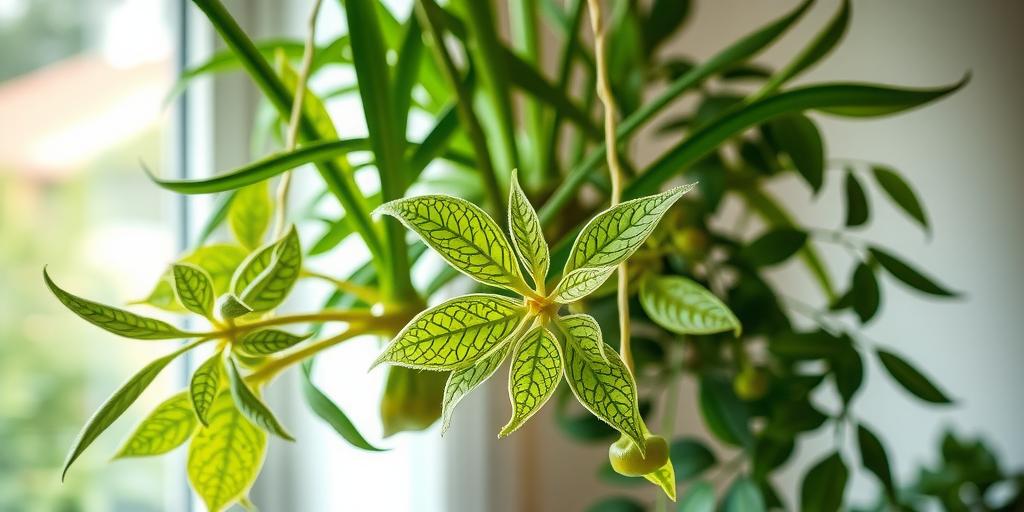
Easy Low Light Hanging Plants for Beginners to Grow Successfully
Discover the best easy low light hanging plants for beginners! Learn how to grow and care for these resilient indoor plants—perfect for dark corners and busy plant lovers.
Introduction
Did you know that some of the easiest plants to grow thrive in low light? If you’re a beginner or have a dimly lit space, don’t worry—you can still enjoy lush, cascading greenery! Hanging plants add life to any room, and many varieties require minimal sunlight and care. In this guide, we’ll explore the best low light hanging plants that even new plant parents can grow successfully. Let’s dive in!
Why Choose Low Light Hanging Plants?
Low light hanging plants are a fantastic choice for anyone living in an apartment, working in an office, or dealing with rooms that don’t get much sunlight. Many homes have spaces with limited natural light, but that doesn’t mean you can’t enjoy lush greenery. These plants thrive in dimmer conditions, making them perfect for brightening up darker corners.
Another great benefit is how low-maintenance they are. If you’re new to plant care or don’t have much time to dedicate to upkeep, these plants are forgiving and easy to care for. Plus, they help improve air quality by filtering toxins, all while adding a touch of natural beauty to your space.
Since they grow vertically, they’re also ideal for small spaces. Instead of taking up valuable floor or table space, they cascade beautifully from hanging baskets, shelves, or wall-mounted planters.
Top 7 Easy Low Light Hanging Plants for Beginners
1. Pothos (Epipremnum aureum)
Pothos is one of the most resilient houseplants out there—it’s practically indestructible! It thrives in low light and can even tolerate fluorescent lighting, making it perfect for offices. Its trailing vines grow quickly, and you can easily propagate cuttings in water.
2. Spider Plant (Chlorophytum comosum)
Spider plants are excellent air purifiers and adapt well to different light conditions, including low light. They produce “spiderettes” (baby plants) that dangle from the mother plant, adding a fun, cascading effect.
3. Philodendron Heartleaf (Philodendron hederaceum)
This fast-growing vine is incredibly forgiving, making it great for beginners. Its heart-shaped leaves add a charming touch, and it thrives in indirect light. Just be sure to keep it out of direct sun, which can scorch the leaves.
4. Peperomia
Peperomia plants come in many varieties, all with compact, colorful foliage. They don’t need much water and do well in low to medium light. Their small size makes them perfect for hanging planters in tight spaces.
5. String of Hearts (Ceropegia woodii)
With delicate, heart-shaped leaves on trailing vines, this plant adds a whimsical touch to any room. It’s drought-tolerant, so it’s great if you occasionally forget to water. Just give it bright, indirect light for the best growth.
6. ZZ Plant (Zamioculcas zamiifolia)
The ZZ plant is nearly impossible to kill—it thrives in low light and can go weeks without water. Its glossy, dark green leaves add a modern, sculptural look to hanging planters.
7. English Ivy (Hedera helix)
A classic trailing plant, English Ivy looks stunning in hanging baskets. It prefers bright, indirect light but can tolerate low light. Just be mindful of its growth—it can get long and may need occasional trimming.
How to Care for Low Light Hanging Plants
Watering Tips
Overwatering is the most common mistake with low light plants. Since they receive less light, they don’t dry out as quickly. Always check the soil before watering—stick your finger about an inch deep; if it’s dry, it’s time to water. If it’s still moist, wait a few more days.
Soil Requirements
Well-draining soil is a must to prevent root rot. A mix of potting soil with perlite or orchid bark helps improve drainage. Avoid heavy, dense soils that retain too much moisture.
Fertilizing
These plants don’t need heavy feeding. A diluted, balanced liquid fertilizer every 4-6 weeks during the growing season (spring and summer) is sufficient. Skip fertilizing in winter when growth slows.
Pruning & Maintenance
To keep your plants looking full and healthy, trim any leggy or yellowing growth. Regular pruning encourages bushier growth and prevents vines from becoming too sparse.
Pest Prevention
Spider mites and mealybugs can sometimes be an issue. Check your plants regularly, especially under leaves. If you spot pests, wipe them off with a damp cloth or use insecticidal soap.
Best Places to Hang Low Light Plants
Bathrooms with Indirect Light
Many low light plants love the humidity in bathrooms, making them a great spot for hanging ferns or pothos. Just ensure they get some indirect light—no completely dark corners.
Shelves or Corners Away from Windows
If you have a bookshelf or a corner that doesn’t get much sunlight, a hanging plant like a ZZ plant or philodendron can bring life to the space.
Offices with Fluorescent Lighting
Most office spaces rely on artificial light, which many low light plants tolerate well. A spider plant or pothos can thrive under fluorescent lights while improving air quality.
Kitchens with Minimal Natural Light
If your kitchen doesn’t get much sun, try hanging a peperomia or string of hearts near a window or under a cabinet. Just avoid placing them too close to heat sources like stoves.
Common Mistakes to Avoid
Overwatering Leading to Root Rot
Less light means slower water absorption. Always err on the side of underwatering rather than drowning your plants. Yellow leaves and mushy stems are signs of overwatering.
Placing in Complete Darkness
While these plants tolerate low light, they still need some indirect light to survive. A completely dark closet or basement won’t work—aim for at least a few hours of ambient light.
Using Pots Without Drainage Holes
Excess water needs somewhere to go. Always use pots with drainage holes to prevent soggy soil and root rot. If you love a decorative pot without holes, use it as a cachepot (place a nursery pot inside).
Ignoring Dust on Leaves
Dust can block sunlight, reducing photosynthesis. Wipe leaves occasionally with a damp cloth to keep them clean and healthy. This also helps you spot pests early.
Conclusion
Growing low light hanging plants is a breeze, even for beginners! With the right choices—like Pothos, Spider Plants, and Philodendrons—you can enjoy lush greenery without needing a sunny spot. Remember to water wisely, provide well-draining soil, and give your plants a little love. Ready to transform your space? Pick your favorite low light hanging plant and start growing today!
